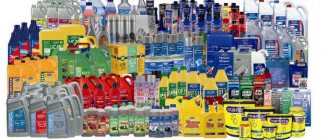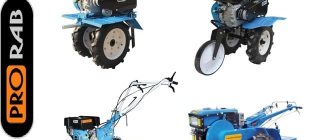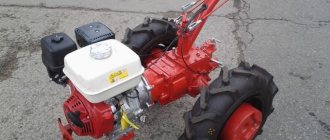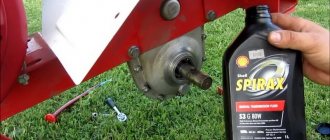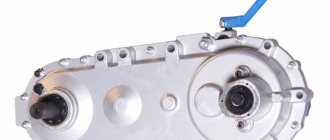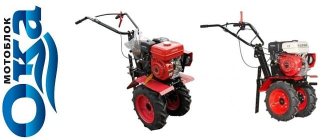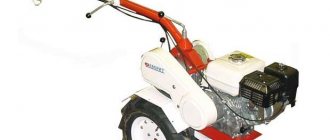As indicated in the walk-behind tractor usage table, the oil should be changed after the first 20 hours of operation or the next year, so I decided to change the oil. If you are in doubt, then looking ahead I will say that the oil was black, so it really was worth replacing .
As you know, changing the oil allows the walk-behind tractor to work longer, but what kind of oil to choose for replacement. In fact, the question is not idle. There is mineral oil. Semi-synthetic. Synthetic.
If the car is filled with mineral oil, the engine needs to be flushed. My walk-behind tractor is filled with semi-synthetic oil, so I bought a container of 1 liter of semi-synthetic oil.
Sequencing
1. The walk-behind tractor needs to be warmed up - this way the oil will drain faster and without any residue. It will be more fluid. 2. Having shut off the walk-behind tractor, take a container of 0.6-0.7 liters and unscrew the plug and lift the walk-behind tractor so that all the oil flows out.
Unscrew the plug and drain the oil into a prepared container
3. Raise the walk-behind tractor and fill in 0.6 liters of oil. To accurately fill, you need to take a measuring container or pour from a jar, focusing on the measuring ruler in it. Filling the engine with oil
So, after adding oil, you can let the walk-behind tractor stand for the oil to drain and get to work.
After transportation, I was recommended to keep the walk-behind tractor for 24 hours so that it could stand in its assembled state, because I was transporting it in the trunk, disassembled, on its side.
material taken from the site https://letnijsezon.ru
Changing the engine oil of a diesel walk-behind tractor
In suburban areas, walk-behind tractors and cultivators are often used. Similar designs are represented by a combination of engine and transmission. Engine maintenance includes timely oil changes. Its purpose is to reduce the degree of friction between individual elements, as well as additional cooling. You can choose oil for a cultivator based on several different criteria.
Faulty compression
It may happen that the compression in the engine has dropped, then you should not make hasty decisions and go to repair it. You can do decoking, since in most cases, loss of compression and increased consumption occurs due to the engine becoming coked with carbon deposits or any unnecessary rubbish getting in there.
If this procedure does not bring results, then you need to repair the engine yourself or turn to professionals, it’s up to you to decide. However, before boring the cylinders and replacing the pistons, check the valve tightness and valve clearances. After everything has been checked and everything is normal, the first thing you need to do is change the oil piston rings and then bore the engine.
What kind of oil to fill
There are a large number of different oils on sale that can be poured into the gearbox and motor. The main classification is as follows:
- Summer varieties are characterized by increased viscosity and are intended for use in the summer. High ambient temperatures cause an increase in viscosity, thereby reducing the load.
- Winter varieties are used in winter and have low viscosity. Negative ambient temperatures cause the viscosity of the oil to increase. Manufacturers take this point into account and make the substance less viscous.
- All-season options are considered the most popular. They can be used in any operating conditions of the cultivator, suitable for four-stroke engines and other options.
In the manufacture of the substance, various bases can be used. On this basis they distinguish:
- Mineral. This option is much cheaper, but does not cope well with the load.
- Synthetic. A similar substance is produced using modern technologies. Therefore, it provides the required level of motor protection against wear and overheating.
- Semi-synthetic. A product from this category is cheaper and, at the same time, is considered universal, because... added to various devices.
Manufacturers produce options for two-stroke and four-stroke engines. A motor cultivator with the first type of engine is much cheaper; maintenance involves adding a lubricant to the fuel.
Transmission
Periodic maintenance of the walk-behind tractor allows you to extend the service life and improve the performance of the equipment. The gearbox is considered one of the most important elements, the purpose of which is to increase the transmitted force. Oil is poured into the gearbox in order to reduce the degree of wear between the two rubbing elements. When choosing gear oil, the following are taken into account:
- degree of viscosity;
- operating temperature;
- type of base used in manufacturing.
Each walk-behind tractor manufacturer indicates the most suitable brands according to GOST. Various gearboxes can be installed with a Honda engine, and the oil is selected based on their characteristics.
For diesel walk-behind tractor
Diesel engines are being installed on Honda and other cultivators. The advantages of such a node are as follows:
- maximum grip on the ground;
- cooling is carried out with air and water;
- Fuel consumption is only 5 liters per 100 km.
Diesel mechanisms are characterized by a complex design, so special attention is paid to choosing the right oil. The classification is carried out as follows:
- CA is an option designed for use under low and medium mechanical stress. The substance can work with low-sulfur diesel fuel. The inclusion of additional elements in the composition eliminates the possibility of corrosion and burning. Not suitable for use under severe operating conditions.
- CB is a substance suitable for use under low and medium mechanical stress when filling high-sulfur diesel fuel. Unlike the previous type, this option provides higher protection against corrosion.
- CC - such oil should be poured into walk-behind tractors under medium and high mechanical loads. Additives reduce the likelihood of deposits forming when exposed to high temperatures.
- CD - this type of oil is used to service an engine that does not have a supercharger on which a turbine is installed. A special composition protects the metal surface from corrosion.
Setting up the engine for the Oka walk-behind tractor
Auto mechanic, specializes in agricultural equipment
Many farmers and summer residents prefer the domestic Oka walk-behind tractor. The manufacturer of this unit is the Kaluga Motor Plant. Many people give their liking to the Oka because of its Russian production and assembly - the device is truly designed for the characteristics of our soils, thanks to which it copes with many different tasks on a plot of land. At the same time, its cost is quite affordable.
Lifan
In many farms and country houses you can find an Oka walk-behind tractor with a Lifan engine. The popularity of this modification is explained by the efficiency of the engine and good functional compatibility with small-sized equipment.
The engine also fits well on a walk-behind tractor. Lifan is a Chinese brand and is a large enterprise leading in its production segment. The engines of this company have earned a reputation as reliable devices with a long service life. Therefore, if the farm uses motorized cultivators, which engine to install on them when replacing it, you can decide by carefully studying the characteristics of the engine.
When choosing, priority attention should be paid to the goals that the equipment faces:
- what is the area of the land plot;
- what tasks should the unit perform (cultivating land, planting, hilling and digging up potatoes, watering, cleaning the site, transporting goods, etc.).
How to make a replacement
Periodic maintenance of the gearbox and engine includes timely oil changes.
Such a procedure should be carried out taking into account the recommendations, because some mistakes made may reduce the reliability of the design.
Oil is poured into the cultivator through a special hole; to simplify the procedure, a watering can is required.
In the gearbox
In most cases, any gear oil can be used to lubricate the gearbox. The replacement procedure is carried out as follows:
- The device is located on a horizontal plane and tilted slightly. This simplifies the filling procedure.
- A probe is inserted into the hole on the gearbox. It is required to determine the level of old substance.
To replenish the oil level in the gearbox, new oil is added. About two liters are poured into a completely dry container. Some models are equipped with a special hole to remove old material, which may contain a large amount of impurities.
In the engine
Changing the engine oil is carried out depending on the manufacturer's instructions. Engine oil is changed taking into account the following points:
- The first replacement is carried out after the engine has been broken in. It is carried out exclusively at idle, because Excessive load can cause wear of the main structural elements.
- Some manufacturers recommend replacement at intervals of 40 hours of operation. The lubricant must be replaced after a period of winter operation.
- Before carrying out the actual replacement, it is recommended to warm up the walk-behind tractor. This is required to increase the fluidity of the substance. In this case, the walk-behind tractor is installed in a horizontal plane. There should be a drain tube at the bottom of the structure; after unscrewing the plug, the old substance is removed.
- After draining the old substance, the plug is screwed back on. There is a filler neck in the upper part of the structure; the level is controlled using a dipstick.
After checking the lubricant level, you can tighten the plug and turn on the engine. The first few minutes need to be run-in at idle speed, because... It takes time to lubricate all structural elements.
Do I need to add oil to gasoline?
You can determine whether oil needs to be added to the cultivator’s gasoline by studying the basic parameters of the device. In most cases, dilution is carried out for a two-stroke engine; recommendations regarding proportions are taken into account. The operation of a four-stroke engine is ensured when refueling with pure gasoline.
It is prohibited to mix gasoline with oil to refuel a four-stroke engine. Such a mixture will cause malfunctions within a few hours of operation.
Stable operation of the moving mechanisms of the walk-behind tractor is ensured by the introduction of lubricants produced in the form of oils with different densities, properties and additives. Oils are consumables that must be replaced at intervals clearly established by the manufacturer. The protection of walk-behind tractor parts from heat, corrosion and increased wear directly depends on lubricants, so the choice of technical fluids must be taken with special responsibility.
Fuel supply system
Fuel filter . In gasoline walk-behind tractors, the filter is installed in the fuel tank tap. It is washed simultaneously with the tank (annually or every 250-300 hours). In diesel technology, the filter is placed inside the tank.
Air filter . It passes through itself and thereby cleans the air going into the carburetor. Dirt on the filter makes it difficult for air to enter. Characteristic signs of contamination: decreased engine power, black soot, poor performance at low speeds.
When running an engine without an air cleaner, the engine wears out quickly. Manufacturers recommend checking the filter after each shift and changing it after 50 hours of operation.
Air filter for SunGarden walk-behind tractor
Various types of filters can be installed on walk-behind tractors: two-element, cyclone, semi-dry, with an oil bath. Depending on the type installed, the replacement and cleaning process has its own characteristics. Consider the option with a two-element engine. Operating procedure:
- Remove the cover and inspect the integrity of the filter parts. If necessary, replace damaged ones.
- Wash the porous rubber element in water using a gentle detergent. Rinse well and dry. You can use a non-flammable solvent (not gasoline).
- Dip the rubber element in machine oil and squeeze thoroughly.
- Clean the paper element from dirt by tapping it on a hard surface.
Carburetor . This engine element is initially adjusted at the factory. During normal operation of the motorcycle, it does not require further user intervention. For some models, the owner's manual contains instructions on how to adjust the carburetor to idle. The content of the operation depends on the engine model. In Honda, the idle speed is adjusted using the throttle valve limit screw.
How much oil is required for a walk-behind tractor engine?
Before independently pouring new oil into a walk-behind tractor, the owner of the agricultural machinery must find out how much liquid is already in the internal combustion engine. It is quite possible that at the moment a complete replacement of the existing lubricant is not required, and instead you can simply add the missing amount of technical fluid.
To independently check the level of contents in the oil tank, you need to:
- Unscrew the plug of the standard filler hole provided in the crankcase of the utility walk-behind tractor;
- Insert the oil dipstick into the factory engine crankcase through the hole provided by the manufacturer, pull it out and check the oil level;
- There are special marks on the built-in probe; as a rule, they are represented by the “MIN” and “MAX” markings. After removing the dipstick, you need to look at what mark the oil stain is located. It should be located midway between these marks. If the liquid level is below o, then you will need to add lubricant;
- If the probe used does not have factory marks, the operator will have to navigate along the length of the device. After measuring the volume of liquid, its volume should reach the middle of the dipstick;
- In some cases, the operator may not have a dipstick. In this case, the amount of lubricant can be checked visually. To do this, you need to look through the filler neck - if the liquid level reaches almost to the neck, then the owner does not need to add engine oil for the walk-behind tractor.
After independently checking the level of the existing lubricant, you need to close the standard filler cap as tightly as possible and make sure that the liquid does not leak out.
How to choose oil for a walk-behind tractor?
Its factory manual for regular use can provide accurate information about a suitable branded lubricant for the built-in motor of a walk-behind tractor. As a rule, the manufacturer indicates the type of liquid, its base and manufacturer’s brand. The company manual also contains instructions from the equipment manufacturer, telling you how much lubricant should be poured into the factory engine and exactly how to do it correctly.
However, not everyone has the original manual for the walk-behind tractor they are using. In this case, the operator needs to remember that, depending on the original purpose, 2-stroke and 4-stroke factory oil are available for sale. Most often, utility walk-behind tractors are equipped with factory-made 4-stroke engines, but immediately before purchasing lubricant, it is still better for the user to first study the markings stamped on the engine wall.
Depending on the type of lubricant base, the market differs between semi-synthetic and synthetic branded oils for walk-behind tractors. In some agricultural equipment stores you can still find mineral-based liquids, but they are increasingly being replaced by synthetic lubricants. There is an opinion among experienced users that synthetic oils are universal and can always be used, regardless of weather conditions. However, this is not quite true. The point is that the existing composition of each type of technical fluid contains various natural components and additives, which, with a sharp drop in temperature, instantly lose their original properties and freeze. That is why factory motor oils are usually divided according to the season of operation - into summer and less viscous winter ones.
Another important factor when choosing technical fluid is its thickness. The oil must envelop the moving parts of the internal combustion engine of the walk-behind tractor, and for this it must be evenly colored and sufficiently viscous. At the same time, you should not choose a liquid that is too thick, otherwise it will not be able to seep into the smallest grooves of the factory engine.
Advantages of Ugra walk-behind tractors
“Ugra” belongs to the class of heavy Russian-made walk-behind tractors. The unit was developed by Kaluga. The factory warranty for the product is given for a period of 24 months.
The machines of this line have proven themselves to be reliable, functional, safe machines that make the farmer’s work easier and reduce the time spent cultivating land.
In addition to its main function - working with soil - the Ugra can be used as a snow blower, a device for collecting and removing garbage, a digger of potatoes and other root crops, and even an earth drill when using the appropriate attachments.
There are many modifications of the Ugra walk-behind tractor, but each of them shares certain features.
Read more about the operational advantages of this series:
- gear reducer and gearbox;
- adjustable steering column (horizontally and vertically);
- two power take-off shafts (allow you to connect additional equipment that is rarely used - pumps, drills, feed crushers);
- powerful engines of domestic or foreign production (depending on the modification: Kadvi, Vanguard, Honda, RobinSubaru, Lianlong, Lifan, DM, Intek);
- power from 5.5 to 7 horsepower (depending on the walk-behind tractor model and engine type).
In addition to the advantages of technical equipment, the Ugra walk-behind tractor also has a number of other advantages, including:
- compactness and ease of assembly and transportation;
- high operating power due to its impressive weight;
The components of the unit include:
- governing bodies,
- transmission,
- power part,
- cultivator,
- wings with fenders,
- opener and hitch, wheels.
Cutters can be added to the kit upon request before purchase (at the buyer's request).
Oil for diesel walk-behind tractor
The engines into which diesel is fueled differ from gasoline power units. Accordingly, to maintain their smooth operation, you need to choose a completely different type of lubricant.
The main factor when purchasing lubricant for a diesel factory engine is its viscosity, marked with the SAE designation followed by a set of letters and numbers.
The latter will tell the buyer in what conditions it is best to use the selected lubricant:
- SAE 0W, SAE 5W or SAE 20W – designed for use in regions with harsh, long winters;
- SAE 20, as well as SAE 40, SAE 60 - marking without letters means that this is a highly viscous liquid that has proven itself well in hot summer weather;
- SAE 5W-30, SAE 10W-40 are all-season oils that work effectively both in winter and hot summer.
The classification presented by the American Petroleum Institute divides motor oils for household and professional walk-behind tractors according to their operating groups. Accordingly, the following types of lubricants are found on the market:
- API CJ-4 - used in proprietary high-quality, very powerful motors, which are designed specifically for operation under high loads. Experienced gardeners recommend using factory-made oils of this particular type for everyday lubrication of engines produced by the Briggs & Stratton and Honda brands;
- API CC - used for power units without built-in superchargers and with turbocharging. These oils provide continuous protection of built-in engine parts from corrosion, gum deposits and increased wear.
When choosing oils of these types, you need to pay special attention to their manufacturers. It is best for users to trust well-known companies, which include the brands Elf, Liqui Moly, Motul, Shell and others.
Main malfunctions of walk-behind tractors
Diesel and gasoline engines have different motor resources. For the former, the normal figure is 4000 m/h, but the latter are capable of providing only 1500 m/h. Despite this, diesel models of walk-behind tractors are not in high demand. After all, both when purchased and during operation they are much more expensive. Therefore, most likely, you are working with a walk-behind tractor equipped with a gasoline (carburetor) engine.
All breakdowns that may occur during the operation of agricultural mini-equipment can be divided into two categories:
In many ways, the success of repairing a suddenly broken machine depends on the correctness of the diagnosis. As for maintenance, it is carried out precisely in order to identify small faults that will later lead to serious ones.
If you do not have the necessary knowledge, premises, tools and materials necessary to service and repair the motor, entrust the work to a specialist!
Is it necessary to add oil to gasoline for a walk-behind tractor?
The answer to this common question can be given based on the type of factory engine of the existing walk-behind tractor. Agricultural units are equipped with 2- or 4-stroke power units. Gasoline for a walk-behind tractor with a factory 2-stroke engine must be diluted with engine oil, being sure to adhere to the proportion specified by the manufacturer.
It is important to remember that 2- and 4-stroke internal combustion engines operate on different principles. Fuel combustion in engines of the first type occurs continuously in 2 strokes. At the same time, the branded oil with which the fuel mixture is prepared contains not only lubricating components, but also additives that improve the quality of the fuel. In 4-stroke factory engines, oil and fuel for the walk-behind tractor are always poured separately, into tanks specially designed for this by the manufacturer.
Worn seals
Another question is if everything is fine with compression, but the car’s exhaust has a bluish tint, then in this case you need to check the seals, since the problem may lie in them and they should be replaced if necessary. But there are times when replacing oil seals does not bring results; this happens if the valve guides do not function.
Is it possible to fill a walk-behind tractor with motor oil?
The difference between internal combustion engines for walk-behind tractors used on farms and modern cars is:
- specifics of the factory design;
- boost level;
- the material from which motor components are made.
The use of automobile factory engine oil for continuous lubrication of the internal combustion engine parts of a walk-behind tractor gradually leads to accelerated daily wear of the latter’s standard chrome-plated cylinders, its piston group, as well as to mechanical damage to the carburetor, factory filter elements and rubber fuel pipes.
Changing the oil in a walk-behind tractor engine
The oil in the walk-behind tractor must be changed strictly following the frequency specified by its manufacturer. Some brands advise doing this every 30–40 hours of working with equipment, others - at least 1 time per 100 operating hours. By following these recommendations, the user will be able to protect the motor from the effects of increased loads and significantly extend its operating life.
The procedure for changing the lubricant in a cold engine of a utility walk-behind tractor looks the same for both imported internal combustion engines of the Subaru brand, and for branded power units of well-known Russian brands Zubr, Centaur, Neva in modifications MB-1 and MB-2, as well as other popular manufacturers. To change the oil in a walk-behind tractor yourself, you must:
- Place a deep, wide container under the lower surface of the engine crankcase, immediately below the standard drain plug;
- Carefully pry up the plastic plug of the standard drain hole, remove it and wait for all the existing used engine oil to flow out;
- Pour about 2 liters of new factory engine lubricant into the empty crankcase and tighten the factory filler plug tightly.
To make it easier for the user to replace the old lubricant with a new one, it is better to use a watering can, which will not allow the oil to splash over the body of the agricultural implement.
Clogged valve
But there are also cases when an increase in pressure in the crankcase and high oil consumption occur for another reason. The culprit may be a clogged valve, which in turn should separate the engine crankcase from the atmosphere. Or large accumulations have appeared in the ventilation system; a filter may be installed in it. It will be enough to simply clean this filter and the engine will work like a clock again.
Oil in the gearbox of a walk-behind tractor - self-replacement
The standard gearbox of any walk-behind tractor needs lubrication no less than its factory engine. The gearbox is initially a complex structure consisting of several gears responsible for transmitting force from the engine to the working parts of agricultural machinery. During operation of the gearbox, the gears are constantly in contact with each other, which leads to the gradual wear of their teeth. To slow down this process, you need to use high-quality lubricant.
You can check the level of lubricant contained in the gearbox at a certain point in time as follows:
- Clean a 70-centimeter piece of wire that will serve as a probe;
- Bend a homemade probe into an arc;
- Insert the wire through the filler hole in the gearbox all the way and pull it out.
If the oil spot is located at a distance of 30 cm from the bottom edge of the dipstick, then there is no need to add oil. Otherwise, the operator must add the missing amount of liquid.
It is necessary to change the lubricant in a cold walk-behind tractor gearbox only if it has been discovered that it has turned a dark, almost black color. Another indicator of the need for urgent replacement is the presence of a large number of foreign inclusions and solid fractions in the lubricant.
How to choose gear oil for a walk-behind tractor?
When choosing a lubricant, consider the following factors:
- Lubricity is the main parameter of any, including branded, transmission oil for the walk-behind tractor used. It is necessary to protect the rubbing parts of the gearbox - gears and bearings from the formation of burrs, grooves and staining. As the viscosity of the oil increases, its ability to lubricate increases. Another way to improve this parameter is to add various additives to the liquid. The viscosity of the lubricant used directly affects its ability to coat the gearbox parts with a durable oily film. At the same time, a viscous liquid quickly thickens at low temperatures, losing its ability to protect the elements of the mechanism;
- resistance to thermal oxidation - this property of the oil is responsible for its stable operation at very high temperatures. To do this, manufacturers add special antioxidant additives to the liquid;
- anti-corrosion protection – the compositions of many branded lubricants for walk-behind tractors contain corrosion inhibitors. Their main function is to prevent the appearance of rust on the moving parts of the gearbox;
- resistance to foam formation - for this purpose, defoamers are added to oils, which prevent foaming of liquids during their operation.
In any weather and operating conditions, ZIC 10W-40 and Gazpromneft Super T-3 85W-90 fluids have proven themselves to be quite good. These oils are distinguished by a wide range of operating temperatures, as well as a high level of viscosity and the content of useful additives.
